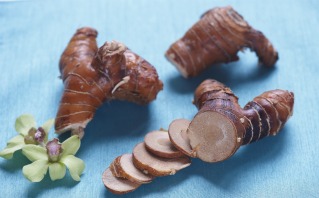Ingredients

A fragrant rhizome related to ginger but very different in flavor, galangal has a distinctive citrusy, earthy aroma and is used as an aromatic flavoring.
The acidulous flesh of the tamarind tree fruit or seedpod, tamarind pulp is used to add a sour note to a variety of Malaysian dishes.
A rhizome also belonging to the ginger family, it is bright yellow in color and has a pungent flavor. More familiar to westerners in its dried, ground form, it's used fresh in Malaysian cooking.
Leaves of a type of lime tree native to Southeast Asia. They add an intense citrus flavor to soups and curries, where they're added whole; or they can be finely chopped and added raw to salads.
A woody, aromatic grass native to India, lemongrass is used in soups and curries as well as salads and stir-fires all over Southeast Asia.
Contrary to popular belief, the curry leaf does not come from the curry plant, nor is it the secret behind the flavor of the curry powder. It is largely a seasoning leaf, to be used to provide a specific tanginess to a dish. Curry leaves are an important ingredient in many Malaysian dishes, particularly curries, sauces, and deep-fried food.
A dried shrimp paste made from fermented ground shrimp, sun dried and then cut into fist-sized rectangular blocks. The paste is raw and is not meant for immediate consumption; it has to be fully cooked to kill bacteria. It's an essential ingredient in many curries and sauces.
Both made by squeezing freshly grated coconut flesh, the cream is richer and has less water than the milk. Coconut cream and milk are used in many Malaysian dishes, including curries, much in the same way that milk or cream are used in French and other western cuisines.
Sprouted green mung beans used as crunchy toppings or in stir-fries.
PRESENTED BY: